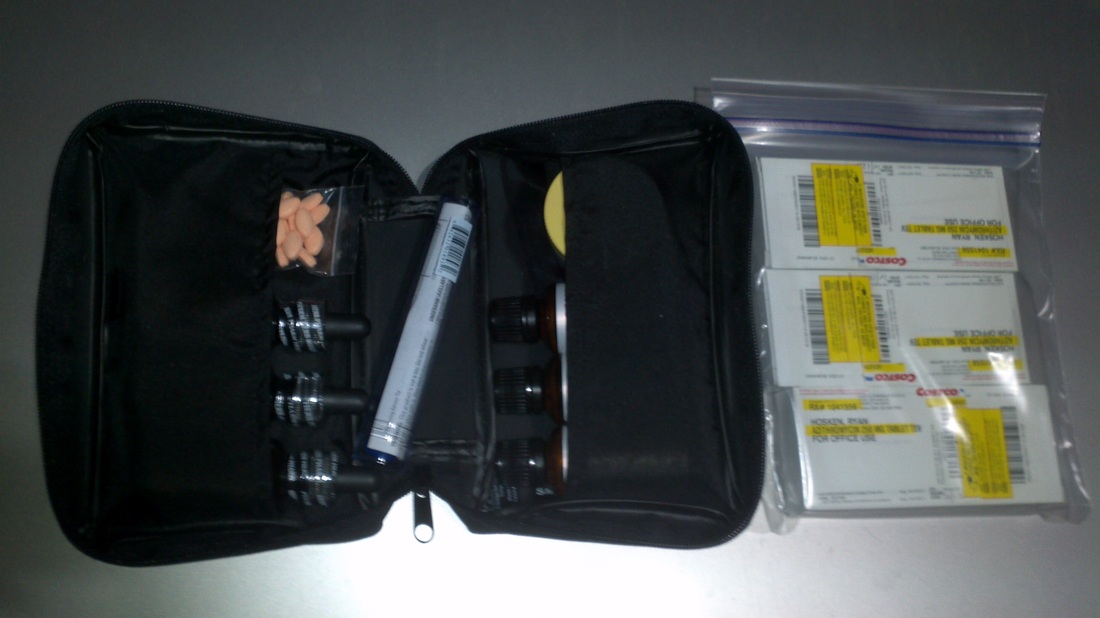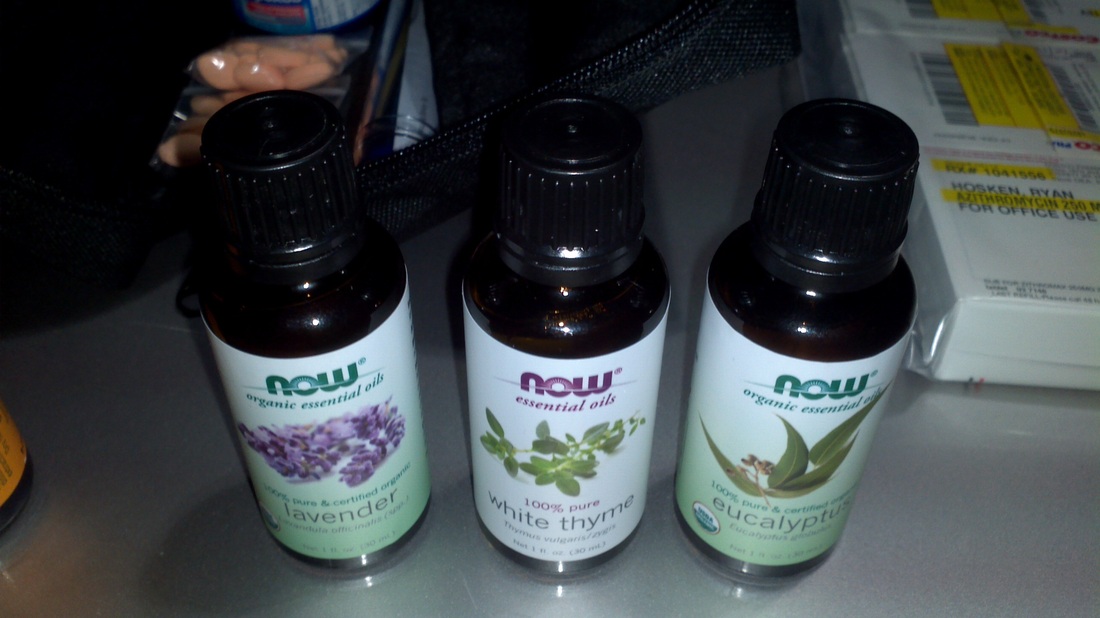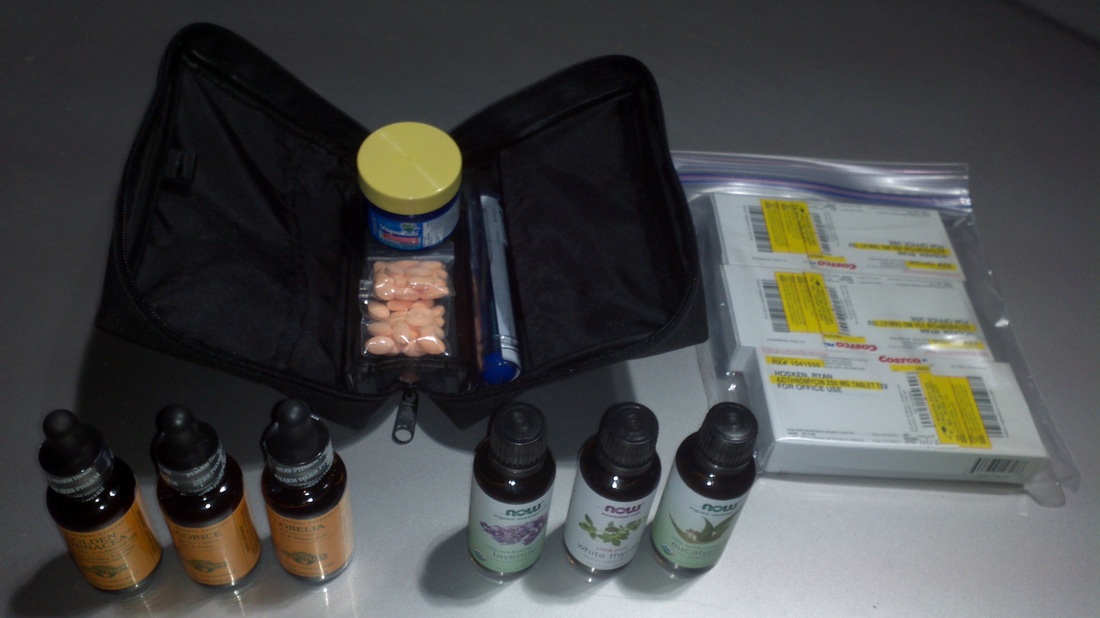Flu Season
These treatments have not been evaluated in the context of Covid-19 or Sars-CoV-2 and should not replace immediate assessment and tretment from a local licensed healthcare provider.
Flu season is an annually-recurring time period characterized by the prevalence of outbreaks of influenza (flu). The season occurs during the cold half of the year in each hemisphere. While the beginning of major flu activity in each season varies by location, in any specific location these minor epidemics usually take about 3 weeks to peak and another 3 weeks to significantly diminish. As a public health issue, there are a variety of preventive measures that can be taken to avoid or minimize susceptibility and symptoms. These include complementary and alternative medicine, as well as conventional medical treatments.
Complementary medicine is designed to work in conjunction with conventional medicine, while alternative medicine is usually prescribed instead of mainstream therapies. The kit discussed here is complementary in nature and most of the components are readily available in stores without a prescription. You can create a kit such as this for yourself and your family to aid with any symptoms or complications of respiratory illnesses during flu season. It is not intended as a substitute to seeking medical care and a licensed healthcare provider is always your best resource for diagnosis and treatment.
While most botanical medications are over-the-counter, you should still consult your health care provider before trying them to rule out contraindications, allergies, or possible interactions with pharmaceutical treatments. There are several excellent plant extracts containing isolates that support lung function, pulmonary circulation, and immune health, decongest, and act as antivirals and antibacterials. These are not homeopathic remedies, but such alternatives are available if you desire.
The six biologically active herbs listed in this kit showcase a few of the more powerful botanical agents that also generally combine well with standard pharmaceutical treatments. They are specific for ameliorating flu-like symptoms whether from the influenza virus, Bordetella pertussis, the bacteria known to cause whooping cough, or Pneumonia of either viral or bacterial origin. While each herb has expanded applications, these specific plant medicines are used in combination for respiratory disorders and are thus very useful during flu season.
Internal medicines (tinctures):
Lobelia - purgative, expectorant, diaphoretic, anti-spasmodic, mucous thinning, anti-smoking agent, similar to nicotine in alkaloid structure, potentially toxic in high doses
Licorice - anti-viral and anti-ulcer, modulates airway constriction, lung inflammation and infiltration of eosinophils in bronchial areas by stimulating CD4 and CD8 immune cell function
Echinacea / Goldenseal - broad immune stimulating action to moderate the immune compromising effects of many steroid medications typically prescribed to open obstructed airways / antibacterial and antiviral
These three tinctures may be taken together or separately and can easily be combined with other medical prescriptions. Consult a pharmacist for potential interactions. They are intended for the acute phase of illness, when symptoms are worsening. One or two droppers full may be taken internally and/or under the tongue several times a day. Discontinue and consult your health care provider if symptoms occur such as a rash, rapid heart rate, or blurry vision as these may be signs of toxicity. Comfrey and/or Elderberry may be added or substituted for varied effects.
External medicines (volatile oils):
Thyme - antiseptic, expectorant, and antispasmodic
Eucalyptus - stimulant, antiseptic, and aromatic
Lavender - antiseptic, anti-inflammatory, aromatic, and anxiolytic (anti-anxiety)
These three volatile oils are applied conservatively (just a few concentrated drops) to hot water and the fumes inhaled as an infusion for several minutes (usually 5 to 15). This can be repeated several times a day, as needed. These are intended for preventive, acute, and chronic phases of illness. Often a towel is tented over the patient's head with the bowl of water beneath to concentrate the aerosolized botanical oils. The oils cannot be taken as liquids internally without harmful effects. This particular kit distinguishes external from internal medicines by a different label, brand, and whether or not they have a dropper. Sage and/or Tea Tree may be added or substituted for varied effects.
The travel version of this kit may include one or more Z-paks (azithromycin), which are prescription. Alternate antibiotics can be provided for those with allergies to azithromycin. Z-paks are intended for use when your symptoms get worse and your health care provider recommends you start one. This is typically initiated to treat primary bacterial infections. Prescription antibiotics may also be started to prevent viral infections from becoming opportunistic bacterial infections due to prolonged immune compromise. Other components of this kit include Vick's VapoRub, a travel staple for its convenience and simple efficacy, chewable papaya enzyme pills for nausea, and Lactobacillus GG, a probiotic for gastrointestinal issues and diarrhea. A thermometer is also very useful.
Again, this is far from a complete medical or first response kit and is not intended as such. It is only intended to address the most common respiratory symptoms that occur in flu-like or respiratory illnesses and may be used in support of conventional medical therapies such as inhalers, antibiotics, steroids, and IV fluids. Vaccines remain your first line of defense and are highly recommended. Talk to your health care provider about any additional vaccines that might be recommend for specific geographical regions before travel.
3 Herbal Remedies for Cold and Flu - an alternate internal formula from the Bastyr Center for Natural Health
http://www.bastyr.edu/news/health-tips-spotlight-1/2013/01/3-herbal-remedies-cold-and-flu
Flu season is an annually-recurring time period characterized by the prevalence of outbreaks of influenza (flu). The season occurs during the cold half of the year in each hemisphere. While the beginning of major flu activity in each season varies by location, in any specific location these minor epidemics usually take about 3 weeks to peak and another 3 weeks to significantly diminish. As a public health issue, there are a variety of preventive measures that can be taken to avoid or minimize susceptibility and symptoms. These include complementary and alternative medicine, as well as conventional medical treatments.
Complementary medicine is designed to work in conjunction with conventional medicine, while alternative medicine is usually prescribed instead of mainstream therapies. The kit discussed here is complementary in nature and most of the components are readily available in stores without a prescription. You can create a kit such as this for yourself and your family to aid with any symptoms or complications of respiratory illnesses during flu season. It is not intended as a substitute to seeking medical care and a licensed healthcare provider is always your best resource for diagnosis and treatment.
While most botanical medications are over-the-counter, you should still consult your health care provider before trying them to rule out contraindications, allergies, or possible interactions with pharmaceutical treatments. There are several excellent plant extracts containing isolates that support lung function, pulmonary circulation, and immune health, decongest, and act as antivirals and antibacterials. These are not homeopathic remedies, but such alternatives are available if you desire.
The six biologically active herbs listed in this kit showcase a few of the more powerful botanical agents that also generally combine well with standard pharmaceutical treatments. They are specific for ameliorating flu-like symptoms whether from the influenza virus, Bordetella pertussis, the bacteria known to cause whooping cough, or Pneumonia of either viral or bacterial origin. While each herb has expanded applications, these specific plant medicines are used in combination for respiratory disorders and are thus very useful during flu season.
Internal medicines (tinctures):
Lobelia - purgative, expectorant, diaphoretic, anti-spasmodic, mucous thinning, anti-smoking agent, similar to nicotine in alkaloid structure, potentially toxic in high doses
Licorice - anti-viral and anti-ulcer, modulates airway constriction, lung inflammation and infiltration of eosinophils in bronchial areas by stimulating CD4 and CD8 immune cell function
Echinacea / Goldenseal - broad immune stimulating action to moderate the immune compromising effects of many steroid medications typically prescribed to open obstructed airways / antibacterial and antiviral
These three tinctures may be taken together or separately and can easily be combined with other medical prescriptions. Consult a pharmacist for potential interactions. They are intended for the acute phase of illness, when symptoms are worsening. One or two droppers full may be taken internally and/or under the tongue several times a day. Discontinue and consult your health care provider if symptoms occur such as a rash, rapid heart rate, or blurry vision as these may be signs of toxicity. Comfrey and/or Elderberry may be added or substituted for varied effects.
External medicines (volatile oils):
Thyme - antiseptic, expectorant, and antispasmodic
Eucalyptus - stimulant, antiseptic, and aromatic
Lavender - antiseptic, anti-inflammatory, aromatic, and anxiolytic (anti-anxiety)
These three volatile oils are applied conservatively (just a few concentrated drops) to hot water and the fumes inhaled as an infusion for several minutes (usually 5 to 15). This can be repeated several times a day, as needed. These are intended for preventive, acute, and chronic phases of illness. Often a towel is tented over the patient's head with the bowl of water beneath to concentrate the aerosolized botanical oils. The oils cannot be taken as liquids internally without harmful effects. This particular kit distinguishes external from internal medicines by a different label, brand, and whether or not they have a dropper. Sage and/or Tea Tree may be added or substituted for varied effects.
The travel version of this kit may include one or more Z-paks (azithromycin), which are prescription. Alternate antibiotics can be provided for those with allergies to azithromycin. Z-paks are intended for use when your symptoms get worse and your health care provider recommends you start one. This is typically initiated to treat primary bacterial infections. Prescription antibiotics may also be started to prevent viral infections from becoming opportunistic bacterial infections due to prolonged immune compromise. Other components of this kit include Vick's VapoRub, a travel staple for its convenience and simple efficacy, chewable papaya enzyme pills for nausea, and Lactobacillus GG, a probiotic for gastrointestinal issues and diarrhea. A thermometer is also very useful.
Again, this is far from a complete medical or first response kit and is not intended as such. It is only intended to address the most common respiratory symptoms that occur in flu-like or respiratory illnesses and may be used in support of conventional medical therapies such as inhalers, antibiotics, steroids, and IV fluids. Vaccines remain your first line of defense and are highly recommended. Talk to your health care provider about any additional vaccines that might be recommend for specific geographical regions before travel.
3 Herbal Remedies for Cold and Flu - an alternate internal formula from the Bastyr Center for Natural Health
http://www.bastyr.edu/news/health-tips-spotlight-1/2013/01/3-herbal-remedies-cold-and-flu




